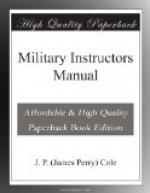Gas attacks may occur at any time of the day, but are most likely to be made during the night or in the early morning.
Gentle rain is without appreciable effect on a gas attack, but strong rain washes down the gas. Fogs have hardly any effect and may, in fact, be taken advantage of to make an attack unexpectedly. Water courses and ponds are no obstruction to a gas cloud.
The gas used by the enemy is generally a mixture of chlorine and phosgene, both of which are strongly asphyxiating. The gases are heavier than air, and therefore, tend to flow along the ground and into trenches, shelters, craters and hollows. The gas cloud may flow round slight eminences, thus leaving patches of country which remain free from gas.
Chlorine and phosgene strongly attack the mucous membranes of the respiratory organs, causing bad coughing. In strong concentrations of gas, or by longer exposure to low concentrations, the lungs are injured and breathing becomes more and more difficult and eventually impossible, so that the unprotected man dies of suffocation. Death is sometimes caused by two or three breaths of the gas. Even when very dilute, chlorine can be recognized by its peculiar smell, which is like chloride of lime, but stronger and more irritating.
Both chlorine and phosgene also exert a strongly corrosive action on metals, so that the metal parts of arms must be carefully protected by greasing them.
The speed with which the gas cloud approaches depends entirely on the wind velocity. Gas attacks have been made with wind velocities varying from 3 to 20 miles per hour, i.e., from 1-1/2 to 10 yards per second. In a 9-mile wind, the gas would reach trenches 100 yards distant in 20 seconds.
Gas attacks have been made on fronts varying from 1 to 5 miles; their effects at points up to 8 miles behind the front trenches have been sufficiently severe to make it necessary to wear helmets.
(2) GAS PROJECTILES:
The use of these is not entirely dependent on the direction of the wind. In gas projectiles such as shells, hand grenades, and trench mortar bombs, a part or the whole of the explosive charge is replaced by a liquid which is converted into gas by the explosion. The explosive force and noise of detonation of these projectiles is less than that of the ordinary kind, and a large number of them are usually discharged into a comparatively small space. After the explosion, the irritant chemicals form a small gas cloud, though some may sink to the ground and remain active for a considerable time.
For using gas shells, the best condition is calm, or a wind of low velocity.
Gas projectiles can be used in all types of country. Woods, bushes, corn fields and clumps of buildings may hold the gas active for a considerable time.
Two kinds of shell gases are used by the enemy, viz., lachrymators, which mainly affect the eyes, and poison gases, which may affect the eyes and are just as deadly as the gases used in the form of clouds.




